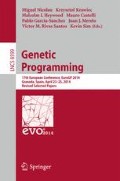Abstract
We propose a simple method of directly measuring a mutation operator’s short-term exploration-exploitation behaviour, based on its transition matrix. Higher values for this measure indicate a more exploitative operator. Since operators also differ in their degree of long-term bias towards particular areas of the search space, we propose a simple method of directly measuring this bias, based on the Markov chain stationary state. We use these measures to compare numerically the behaviours of two well-known mutation operators, the genetic algorithm per-gene bitflip mutation and the genetic programming subtree mutation.
Access this chapter
Tax calculation will be finalised at checkout
Purchases are for personal use only
Preview
Unable to display preview. Download preview PDF.
References
Bertsimas, D., Tsitsiklis, J.: Simulated annealing. Statistical Science, 10–15 (1993)
Dignum, S., Poli, R.: Crossover, sampling, bloat and the harmful effects of size limits. In: O’Neill, M., Vanneschi, L., Gustafson, S., Esparcia Alcázar, A.I., De Falco, I., Della Cioppa, A., Tarantino, E. (eds.) EuroGP 2008. LNCS, vol. 4971, pp. 158–169. Springer, Heidelberg (2008)
Droste, S., Jansen, T., Wegener, I.: On the analysis of the (1+1) evolutionary algorithm. Theoretical Computer Science 276(1), 51–81 (2002)
Eiben, A.E., Aarts, E.H.L., Hee, K.M.V.: Global convergence of genetic algorithms: A Markov chain analysis. In: Schwefel, H.-P., Männer, R. (eds.) PPSN 1990. LNCS, vol. 496, pp. 3–12. Springer, Heidelberg (1991)
Garnier, J., Kallel, L., Schoenauer, M.: Rigorous hitting times for binary mutations. Evolutionary Computation 7(2), 173–203 (1999)
Hu, T., Payne, J.L., Banzhaf, W., Moore, J.H.: Evolutionary dynamics on multiple scales: a quantitative analysis of the interplay between genotype, phenotype, and fitness in linear genetic programming. Genetic Programming and Evolvable Machines 13(3), 305–337 (2012)
Kemeny, J.G., Snell, J.L.: Finite Markov chains, vol. 210. Springer, New York (1976)
Koza, J.R.: Genetic Programming: On the Programming of Computers by Means of Natural Selection. The MIT Press, Cambridge (1992)
Levin, D.A., Peres, Y., Wilmer, E.L.: Markov chains and mixing times. AMS Bookstore (2009), http://pages.uoregon.edu/dlevin/MARKOV/
Moraglio, A., Krawiec, K., Johnson, C.G.: Geometric semantic genetic programming. In: Coello, C.A.C., Cutello, V., Deb, K., Forrest, S., Nicosia, G., Pavone, M. (eds.) PPSN 2012, Part I. LNCS, vol. 7491, pp. 21–31. Springer, Heidelberg (2012)
Moritz, R., Ulrich, T., Thiele, L., Buerklen, S.: Mutation operator characterization: Exhaustiveness, locality, and bias. In: Congress on Evolutionary Computation. IEEE, New Orleans (2011)
Ni, J., Drieberg, R.H., Rockett, P.I.: The use of an analytic quotient operator in genetic programming. Transactions on Evolutionary Computation 17(1) (2013)
O’Reilly, U.M., Oppacher, F.: Program search with a hierarchical variable length representation: Genetic programming, simulated annealing and hill climbing. In: Davidor, Y., Schwefel, H.-P., Männer, R. (eds.) PPSN 1994. LNCS, vol. 866, pp. 397–406. Springer, Heidelberg (1994), http://www.springer.de/cgi-bin/search_book.pl?isbn=3-540-58484-6
Pagie, L., Hogeweg, P.: Evolutionary Consequences of Coevolving Targets. Evolutionary Computation 5, 401–418 (1997)
Poli, R., McPhee, N.F., Rowe, J.E.: Exact schema theory and Markov chain models for genetic programming and variable-length genetic algorithms with homologous crossover. Genetic Programming and Evolvable Machines 5(1), 31–70 (2004)
Author information
Authors and Affiliations
Editor information
Editors and Affiliations
Rights and permissions
Copyright information
© 2014 Springer-Verlag Berlin Heidelberg
About this paper
Cite this paper
McDermott, J. (2014). Measuring Mutation Operators’ Exploration-Exploitation Behaviour and Long-Term Biases. In: Nicolau, M., et al. Genetic Programming. EuroGP 2014. Lecture Notes in Computer Science, vol 8599. Springer, Berlin, Heidelberg. https://doi.org/10.1007/978-3-662-44303-3_9
Download citation
DOI: https://doi.org/10.1007/978-3-662-44303-3_9
Publisher Name: Springer, Berlin, Heidelberg
Print ISBN: 978-3-662-44302-6
Online ISBN: 978-3-662-44303-3
eBook Packages: Computer ScienceComputer Science (R0)

